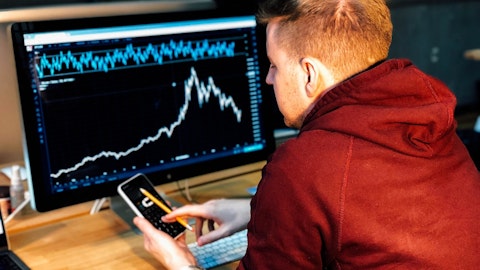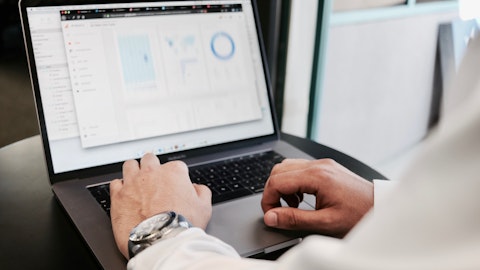Burford Capital Limited (NYSE:BUR) Q3 2023 Earnings Call Transcript November 9, 2023
Operator: Thank you all for joining and good morning. I would like to welcome you all to the Burford Capital Q3 2023 Results Call. My name is Brika and I’ll be your moderator for today’s call. All lines are on mute for the presentation portion of the call today with an opportunity for questions and answers at the end. [Operator Instructions] I would now like to pass the conference over to your host Christopher Bogart, CEO of Burford Capital to begin. So, Chris, please go ahead.
Christopher Bogart: Thanks very much, and hello, everybody. Thank you for joining us today. As usual, with me are Jon Molot, Burford’s Chief Investment Officer, and Jordan Licht, Burford’s Chief Financial Officer. And each of us will speak a little bit on this quarterly call and then we’ll be happy to take your questions. I’m going to start on slide two, sorry, slide three, which is sort of an overview synopsis of what we have to tell you today. And my fundamental message here is that we’re having a blowout year. Things are just really going very, very well from our perspective. Just looking at the first number there on the slide, topline revenues are up five times. And the thing that is really important to reflect on is that, while our success in the YPF cases is driving some of this, so too is the rest of the portfolio.
And so, while in YPF, we had an extraordinary win with a judgment for more than $16 billion, the largest in the history of the issuing court. And Jon is going to talk some more about YPF when we get to a specific slide on it. So while that’s a fantastic outcome, I really want to focus on cash and on what’s going on in the rest of the portfolio as well, because the portfolio really has been moving forward after its pandemic hiatus. And so what we’ve seen just in nine months is we’ve seen almost $400 million of cash come in. And again that’s not a single dollar of that cash is coming from YPF. That’s all coming from the rest of the portfolio, which has been sitting slightly dormant while courts coped with the pandemic and now we’ve seen a real resurgence in activity.
And as you’ll see later in these slides, more than half of our activity in the period is coming from matters that are pre-2020 in the portfolio. So exactly as we have predicted. We had a delay for a while, but we did not have any substantive impact from that delay. And that delay is now clearing itself and things are moving through the portfolio. Again you look at realized gains, basically doubling in the period. Again no contribution there from YPF. So in terms of performance, in terms of the portfolio’s output and activity levels and again even looking at unrealized gains showing that things are moving, we’re just very pleased with how things have been shaping up this year. The portfolio as a whole is also growing, as we see both continued new business coming into that portfolio as well as the continued development of the cases that are already in there.
And then a couple of other key points as we move through this slide, one of them is our sovereign wealth fund partnership, which as we announced a little while ago has been extended and expanded. And sometimes it’s not so easy, given the way that we account for this sovereign wealth fund arrangement, to see its leverage in the business. Because it’s consolidated into our financial statements, but if you break that apart, we’re now well over $100 million in income from doing that arrangement. So we’re really very pleased with how that’s going and with the asset management contribution to the overall profitability of the business. And of course we ended the period with very substantial cash on hand, with very significant liquidity, just because of all of the cash that we have generated, augmented by the notes that we issued earlier this year.
So all-in-all very happy with where we sit nine months into 2023. Turning to slide four. This is fundamentally accounting. And it’s obviously important and Jordan is going to talk to you about many of these issues in more detail. But I think that, while at the same time emphasizing the incredible growth that we’ve seen in so many of these numbers, just things going up by five times and more, I think you also can’t take your eye off the cash and we generated lots of cash, as I said on the prior slide. And I would just as we when we run the business do this and just as you’ve seen in some of the analyst notes that have come out today, I would really continue to focus your attention on the cash performance of the business and not be taken in by all of the accounting dynamics and some of the accrual noise.
So, for example, when you look at expenses on an accounting basis, and Jordan will talk more about this, the expenses look like they’ve gone up a fair bit, but that’s largely because of non-cash items around, for example, the increase in our share price and the increase in the unrealized gain value associated with the YPF case. If you look at sort of run rate cash operating expenses, those really have barely budged. And as I said, Jordan will talk more about those. It’s pretty nice to see these book value numbers on the slide, more than $10 a share in book value, $9.5 intangible book value. I think that when you look at those book value numbers and look at the combination of our growth and profitability, and then turn your eyes to the share price, you see a degree of mismatch there that we hope will continue to close in the context of the US market especially.
And obviously we point out the significant impact on return on equity that these results have had over the last nine months. So with that let me turn you over to Jordan.
Jordan Licht: Thank you, Chris. Good morning and good afternoon to everyone. I’m on page five. So here, as Chris mentioned, we break down our capital provision income into the various components for both the three and nine-month periods. Looking at the year-to-date comparisons of 2023 versus 2022, they show nearly a doubling of all the income metrics. Realized gains this year to-date are $125 million and unrealized gains excluding YPF are $85 million. With respect to YPF, as everyone knows, we’ve had two milestones in the case so far this year and Jon will speak a little bit more to that shortly. The initial summary judgment and the subsequent award of damages, as a result, we have unrealized gains of $460 million over the first nine months of 2023 from our YPF related assets.
Total capital provision income had a huge increase year-over-year from $676 million versus the $80 million last year. I’m going to switch now to page six and talk a little bit about asset management. Our asset management business continues to perform and we continue to reap the rewards of using the funds to augment our balance sheet efforts. In the first nine months of both 2022 and 2023, we earned $41 million of asset management income. And on the bottom of the slide, we highlight the mutually beneficial relationship we have with our sovereign wealth fund partner. As we announced earlier this fall, the relationship extended through the end of 2024. Total income from BOF-C has been steadily increasing year-over-year. And before I turn away from asset management, our cash receipts from asset management is double through the first nine months compared to last nine months — compared to the nine months in last year at $29 million.
So let me turn it over to Jon.
Jonathan Molot: Thanks, Jordan. Thanks to everybody for joining. If you turn to slide seven, it’s a familiar slide, but it bears emphasis and we update the numbers with each period. But it shows just how our portfolio has performed because when you’re buying into Burford, and part of what you’re buying is this diverse portfolio of investments and if you look at how that portfolio has performed in the past based on realizations, you see there’s a large number. It’s $2.5 billion worth of realizations over roughly 14 years. And that gives you a track record you can look at. And the numbers shift slightly from period-to-period, but they’ve been pretty consistent. You see a cumulative return on invested capital of 87%, you see an IRR of 27%.
And, of course, that’s broken down into three categories. We have investments that resolve through adjudication and we win more than we lose. And where we win, you see the returns are really quite attractive. But then a large segment of our investments resolves through settlement, and those returns too are attractive. The ROICs and IRRs are not as large, which is what we understand when we go into them. There’s, of course, a discount for a settlement. But nonetheless, the numbers are quite attractive and this has led to consistently attractive performance, which is why we love this business so much. We see assets we can invest in, where we can help our counter-parties and it’s a win-win. And you, our shareholders, bear the fruits of this and have in the past.
If we turn the page, we turn to one particular asset that, of course, has the potential to generate considerable upside, actually outsized returns. And historically, I’ve not said very much about what to expect in the future of YPF. It was not in anybody’s interest to do so. And I’ll maintain that position but I can tell you what has happened so far and where we are, which is a lot. So we had the trial in July, and we won a final judgment. It was a complete win for the plaintiffs of a $16 billion judgment, which was at the high end of the possible range of damages. Argentina has filed a notice of appeal to the Second Circuit Court of Appeals for those who have followed the case for a while. There was a prior interlocutory appeal years ago about sovereign immunity, but this one will be a second appeal.

And they will have the right then to seek discretionary review from the Supreme Court of the United States, which takes a very small portion of the cases that are petitioned for. In addition, Argentina has asked the trial court to stay enforcement of the judgment pending the appeal. In the United States, a final judgment is immediately enforceable when it’s issued, typically unless the defendant posts a bond to secure the judgment, and Argentina has asked the court to relieve it of the bonding requirement and grant a stay without a bond. That is fully briefed before the judge in the Southern District. And we expect that to be decided soon. The appeal will take a little bit longer. That is not fully briefed, and it also includes a cross appeal by the plaintiffs against YPF.
You’ll recall that the judgment that was issued by the court was against Argentina only. YPF was not held liable and the plaintiffs have cross appealed, asking that the judgment extend to YPF as well. That would not change the damages amount, it would just include YPF as liable if it were to succeed. And that will go through the appellate process. Just as a reminder, the Burford only net entitlement is roughly 35% of proceeds from the Petersen case and roughly 73% of proceeds from the Eton Park case. So I’ve said a little bit about how the portfolio as a whole has performed because when you buy Burford stock, you are buying a portfolio. I’ve said a bit about how the YPF asset in particular has performed up to this date because we’ve always said that is one of the pillars you are buying.
And then, of course, the other thing you are buying when you buy Burford stock is a business model that has been able to continually invest in new assets that we deem attractive and that we think have potential to generate returns. And so, for that portion of it, I’m going to turn it back over to Jordan to turn to slide nine.
Jordan Licht: Thank you, Jon. On slide nine, as you can see, we’re ahead of last year’s pace with respect to both commitments and deployments on a year-over-year basis. 2023 has been a productive year. As the global leader in litigation finance, we have the ability to support clients with significant commitments and deployments of capital, using both our balance sheet capacity and third-party funds. And so, we continue to deploy cash from the balance sheet into attractive assets, targeting returns north of 30%. And as I mentioned before, the partnership with BOF-C on these assets on a 75-25 split. With this continued deployment, our total deployed cost on the balance sheet has grown to over $1.6 billion. I’m switching to page 10 to outline some of the expenses for the first nine months of the year, and I know Chris had touched on a little bit of this and I’ll go slightly deeper.
At first glance, these seem a fair bit higher than the previous year, but we really need to separate out the cash and non-cash expenses and some of the idiosyncratic movement in these line items. So I’m going to pick on a couple examples. So the first is, while our salaries and benefits might appear to have grown by slightly over $10 million [Technical Difficulty] of that net change is directly related to retirement plans. So as a reminder, and I’ve mentioned this before, our employees have the ability to invest their deferred compensation in Burford stock, and when the share price increases, we have a corresponding accrual expense. The other example relates to the positive events associated with YPF. We have a net $21 million increase year-over-year in our carry plan, given the positive events from this year.
And remember, that’s only paid when the cash is received. And finally I want to remind folks that the legacy asset recovery accrual was related to a historical purchase of that business. Effectively, one could consider that like an earn-out and there’s only one remaining asset left in that deal. So I’ll now switch to the next page to talk a little bit more about cash. So I’m on page 11. This is our traditional liquidity page and I’ll jump around and hit some of the highlights. On the top left, cash receipts were $380 million year-to-date, which surpasses the total for all of 2022. Our liquidity and receivables are in a strong position as of period-end, highlighted by $347 million of cash and securities as well as $70 million of receivables.
We still don’t intend to hold cash quite near these levels then our goal is to put it to work. But as Chris mentioned, we’re digesting both the bond issuance and the cash realizations that have occurred. And then finally, on the bottom of the page, we outlined the nine month cash bridge for Burford only. To put it simply, we’ve had $380 million of cash against the cash spend of $159 million, which is the OpEx and interest expense. I’m then moving to page 12. Just a quick reminder on covenants and debt levels. So we continue to enjoy and have built a laddered debt schedule that extends out to 2031 and our next maturity is not until August 2025. The other takeaway that I have or that I see from this slide is that only 25% of our debt matures in the next four years.
So we have kind of ample runway. On the bottom of the slide, our leverage levels remain well below covenant levels. And to wrap it up, you’ve seen the bullets on the left, both Moody’s and S&P have both recently raised their outlook from stable to positive. With that I turn it back to Chris.
Christopher Bogart: Great. Thanks, Jordan. And I’m now on slide 13. You’ve seen the format of this slide before, but the content of it has been updated for our current results. And what the slide really does is underline the point that Jon was making earlier. When you buy stock in Burford, you’re buying four different things. You’re buying an existing portfolio of litigation assets. We have given a lot of detail about what’s in that portfolio and its activity levels. We’ve now got a very long and substantial track record in generating desirable returns from that portfolio, making it past — making around $2.5 billion of cash recoveries. And again, these are all cash numbers. There’s no accounting stuff going on in the portfolio return numbers.
So you’re starting off by buying a large, diversified portfolio with a long track record history of generating desirable returns. You’re adding to that the industry leading origination platform, which has shown itself capable of generating new business on a very regular and reliable basis. And you see there the numbers of people that we have and our really global presence. We are also a very sizable asset manager, and we’re delighted especially to see the performance of not only our funds in general, but of our BOF-C, our sovereign wealth fund arrangement, which, as I said earlier, has really started to throw off income for us. And finally, then you’ve got the YPF assets, which Jon touched on and which have the potential in the future to generate truly outsized returns for us.
So that’s the package that you get with an equity investment in Burford, and we’re very pleased about where the business sits today. And with that, we’re happy to take your questions.
Operator: Thank you.
Christopher Bogart: I see that we have, go ahead, operator. Sorry.
Operator: [Operator Instructions]
Christopher Bogart: And we’ll start with a question from the webcast from Paul de Gruchy, which is basically while it has always been Burford’s policy to not talk about individual cases, are there any cases currently progressing that have the potential to produce returns of a similar size to YPF? So you’re right that we don’t really talk about individual cases. But I think it’s fair to say that when we contemplate a case that has at least the potential to deliver billions of dollars, plural, to Burford depending on the ultimate outcome of that case, that I think is an unusual case for us. And now I think we have a question on the phone.
See also 12 Best Internet of Things (IoT) Stocks To Buy and Billionaire Paul Singer’s Top 10 Holdings and Recent Moves.
Q&A Session
Follow Burford Capital Ltd
Follow Burford Capital Ltd
Operator: Thank you. We have our first question on the line from Alexander Bowers of Berenberg.
Alexander Bowers: Good afternoon, everyone. Can you hear me?
Christopher Bogart: Yes, we can.
Alexander Bowers: Brilliant, I just had one question on the value of the YPF asset. We’ve seen the YPF asset shift up after the summary judgment and the final judgment rulings this year. But I just wanted to ask about how you’re thinking about the evolution of its valuation going forwards in terms of factoring the remaining litigation risk from the appeal process, the expected duration of any payout and then the other factors kind of factoring into that process.
Christopher Bogart: I think probably all three of us have something to say about that. But let me just start by saying that, just to remind you that unlike most of our litigation finance assets, where we effectively are calibrating model valuations to the investment that we’re making, or the investment terms that we’re agreeing to, in the YPF case, we had a substantial and very profitable secondary sale of a portion of that — of our interest in the matter in 2019. And that 2019 sale served as the basis for calibrating the model. So we’re already starting with the — effectively, a third-party validation. And then, then we go through our usual process to adjust the value based on events which drive the litigation risk premium. And Jon, Jordan, feel free to pick that up.
Jonathan Molot: Well, I would just say, in terms of the events, the most prominent or the only one you can think of that’s significant at this point, clear litigation event remaining would be the resolution of the appeal by the US Court of Appeals for the Second Circuit. And then, there is the discretionary circ petition to the Supreme Court, which is less of an event, but still an event. So those are the remaining US Court events. Of course, there is, as I mentioned, this stay application that is pending, and then there’s an enforcement proceedings, discovery and all sorts of other stuff. But those don’t necessarily drive valuation under our approach, in the same way that the litigation events that we’ve experienced so far, such as summary judgment and a trial victory do and as an appeal or the end of all appeals would.
And we don’t change valuations based on the sentiment. So the fact that there are discussions — those are not the sorts of things that would drive a valuation change.
Jordan Licht: Chris, I know you said all three of us might have a comment on it, but I think the two of you did well. Like as you mentioned, we have a model for this. Jon outlined — in case there are events that are observable with respect to milestones in the court case, those could obviously change value. And otherwise, I don’t think there’s a lot more to add.
Alexander Bowers: Thank you.
Christopher Bogart: Thank you.
Operator: We now have Portia Patel of Canaccord. You may proceed with your question.
Portia Patel: Thank you for taking my question. I’m just looking at the Burford only data in your release, and I wondered if you could just provide some color on why, in Q3, the commitments and deployments were materially lower than in previous quarters and year-on-year. And any comment on how we should expect those commitments and deployments to trend in Q4 and Q1 would be helpful. And I think, if you could provide an indication of what you would suggest a reasonable expectation or objective is for an annual commitment and deployment figure on a Burford only basis. That would be very helpful? Thank you.
Christopher Bogart: Sure. So as I’ve said before to this audience, I think quarterly reporting is for the birds and I pay really absolutely no attention to it. It’s something that we have to do, with our US presence here. But I think it’s roundly perceived as undesirable by lots and lots of people who are much more experienced than I am in the markets like Warren Buffett and Jamie Dimon. And so, we do it because we have to, but it’s not something that we worry about driving the business to. And the fact that these numbers go up and down, a little bit from time-to-time has no particular meaning to us. We closed a really, really, really big deal in June of 2023. And we didn’t close a really, really big deal in September of 2023 and that says nothing whatsoever to me about the overall state of the business.
If you look in more general terms, we’re putting out a meaningful amount of capital against new investment matters and I really look at a longer scale, broader approach to deployment of capital. And that sort of bleeds over into your broader question. When you think about what this business is doing today, it’s different than what it was doing a few years ago. So if you go back to Burford’s first few years, Burford was fundamentally working with law firms. And the dynamic in the business was that corporate clients were coming to law firms, wanting to hire them, but not wanting to pay their hourly fees, and they were looking for a financial alternative just to address that fee issue. In other words, just to provide some budget and some P&L relief for the corporate clients.
And so, we would step into that matter, we would work with the law firm and we would find a financing arrangement that would pay the law firm’s fees and give the corporate the contingent solution that it was seeking. And those deals tend to be smaller deals because they are, number one, they’re single cases, and number two, they’re just addressing the legal fees. And so, there’s a natural limit to how much you can spend on cases. Even though lawyers are expensive and getting increasingly expensive, you’re still not spending $100 million to litigate a single piece of litigation, except in the most extraordinary circumstances. So as the business has evolved — and that — we still do that business, and we do lots of it because that is effectively the starter deal.




